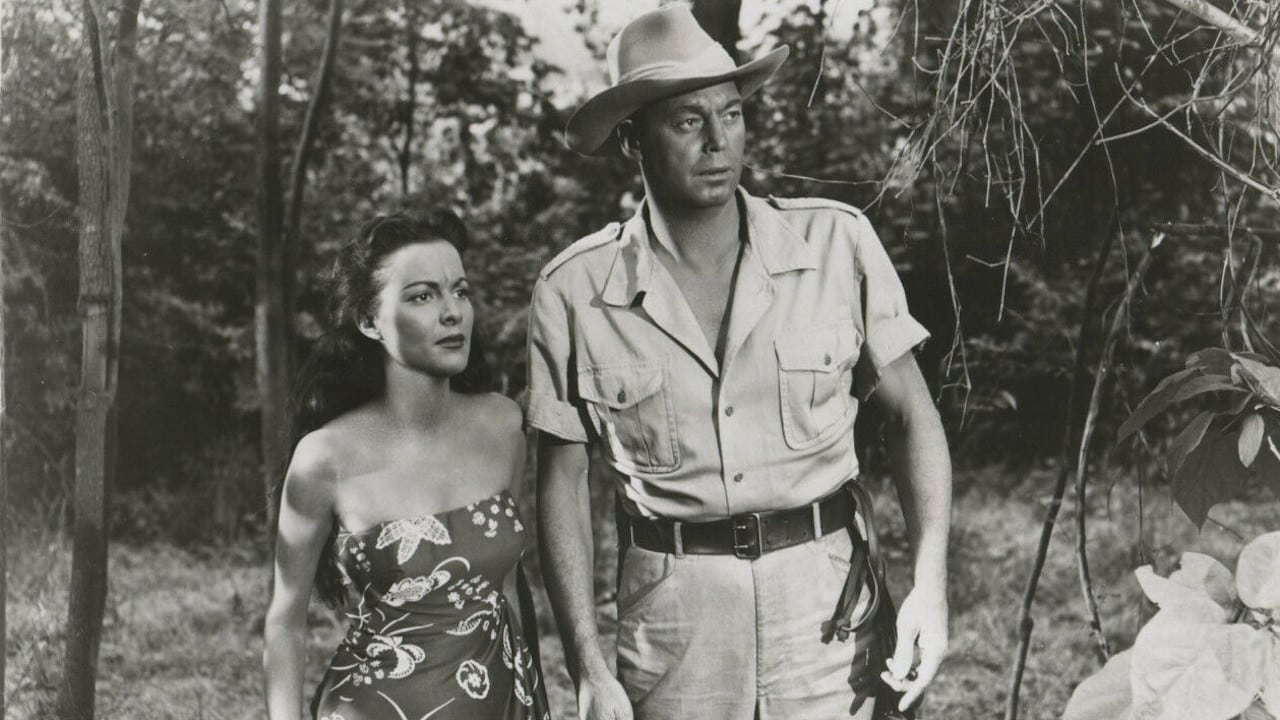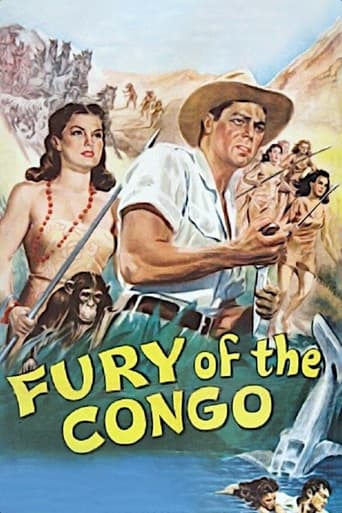

For this low budgeted film, the sixth in Columbia Pictures' Jungle Jim series, based upon a long-running comic strip of Alex Raymond, creator also of "Flash Gordon" and others, Jungle Jim (Johnny Weissmuller) is able to save an about to drown aircraft pilot, Ronald Cameron (William Henry) whose plane has crashed and sunk beneath a pond into which Jim is about to plunge. Cameron, who might not be the police inspector whom he claims to be, is tracking a missing biology professor who had been field researching an unique beast, the "okongo", that the script's pages describe as some type of hybrid between an antelope and a zebra. While local natives venerate this creature, "evil white" hunters plan to capture the entire herd because the okongo's digestive system transmutes, in some mysterious fashion, its favourite food plant into a powerful and, to be sure, potentially lucrative narcotic drug. These "evil whites" force the men of the local tribe to assist them in locating the okongos, leaving the tribeswomen to call upon Jungle Jim to stop the invaders from absconding with the entire host of the beasts. As champion of the females, Jim confronts numerous perils, from both human and animal adversaries. These include a savage fight to the death at close quarters with a leopard (utilizing footage with a stunt double used regularly for previously released Jungle Jim adventures), a struggle with a "giant desert spider" (obviously a garden hose garnished with palm fronds), and a group of the hostile white men to whom Jim is simply an inconvenience (although one spotlessly attired, whose clothing bears not the least sign of the brutal combat with the leopard, or of the ground-hugging opposition offered by the oversize spider, from which no living being could have reasonably been expected to escape). The film is shot in Southern California locations that bear scant resemblance to the scenario's purported African Congo. Nor does the assorted collection of Central Casting extras, comprised in the main of flabby Filipinos and Hispanics, match the expected appearance of indigenous Africans. These worthies, all barefoot, move with ever so much care through the locations' hard-rock strewn terrain during the course of the work's repetitive scenes of the varying characters who are tirelessly walking for no ostensible purpose. There is yet more for a viewer to chuckle over here: the okongos are only ponies stabled at Corriganville, an often used site for Western movies, and have stripes painted sloppily over their flanks; in order for Jim to be trusted by female members of the tribe, he must know the "tribal sign", and he of course does; his omnipresent pet chimpanzee, here named Kanga, in a clearly unplanned adaptation from the script, swings by way of vine, knocking Jim into a mud puddle, that is then labelled as "quicksand". There is a good deal more of such foolishness, but no advantage is to be gained by flogging a dead okongo for this haphazardly edited, listlessly directed affair that relies upon stock footage and scoring with the entire assemblage of players chasing each other about to no design during the movie's closing one quarter of an hour, or so.
... View MoreTaken out of its context as a low budget Saturday afternoon matinée, "Fury Of The Congo" doesn't stack up very well against "real" films. But compared to other Tarzan and Jungle Jim films, "Fury Of the Congo" is pretty good. It seems to have a lot more actual outdoor footage than many of the other JJ/Tarzan films of that era, the direction and screenplay are better and snappier...and either Weismuller is quite a bit better delivering his lines than he normally is, or else I'm just getting used to his wooden acting. Parts of the film are actually a fair amount of fun to watch: Tamba accidentally knocks Jim into a quicksand patch at one point, Jim escapes from armed pursuers by breathing thru a reed while he hides underwater, and yes, Jim swings from tree to tree on a series of vines at another point. The movie ends with an energetic mêlée between the bad guys and Jim/Tamba/the enslaved native tribe/their spear wielding Amazonian wives that melds with with a zebra (or Okongo) stampede and a sandstorm.The one thing that doesn't quite work is the scene that got the movie included in the science fiction/fantasy compilation, "Keep Watching The Skies!" - the giant spider attack. In the context of the film, this makes no sense whatever, and worse, it's a pretty dull little scene - the spider costume is utterly unconvincing as it tries to choke Jim, and Jim cuts on the spider's legs until it lets go, and well, you can imagine the rest.You don't look for high quality film making in a Jungle Jim film...you just want nostalgia. This one managed to avoid sucking enough that I was able to enjoy it as a flashback to my 8 year old movie watching experience.
... View MoreIf you've seen more than a couple of Johnny Weismuller's 'Jungle Jim' movie adventures, you won't have any trouble spotting the scenes repeated from earlier films in the franchise. "Fury Of The Congo" has at least two, utilizing Jim's wrestling match with a leopard from the first film of the series ("Jungle Jim"), and later on there's a view of Tamba the chimp in a vine swing over a ravine from the prior picture, "Captive Girl". Come to think of it, those shots of the mountain top pass might have been the ones used in "The Lost Tribe" as well. That's one thing the Poverty Row producers of the era did well, and that was to economize wherever possible.At least a little more creativity went into this story than we've seen before. The plot deals with a rare jungle animal called the 'Okongo', described as a cross between an antelope and a zebra. That of course presumes that interspecies breeding is possible, but since it isn't, it's at this point you can leave your thinking cap on the couch. Curiously, dark Okongos have a pattern of white stripes, and light colored ones have the same pattern in black stripes, in a way that zebras just can't duplicate. It gets better. The Okongos feed on a rare narcotic plant (sounds like 'madro'), and then produce a glandular drug that has an even more concentrated effect. That makes them a prime target for drug smugglers who want to capture the Okongos for illicit trade. I found it pretty interesting that with all the rare animals they might have come up with to use in a story line, it's probably best that the writers made this all up.The creativity doesn't end there either. This is the first time out we see Jungle Jim use a bolo as a weapon, and with great accuracy of course. Besides the leopard mentioned earlier, Jim also defeats a giant hairy tarantula-like spider in an awkward looking battle where he's on his back the entire time. You know, you can say all you want about Superman, but the real Man Of Steel was Jungle Jim. In film after film, going hand to claw with lions, tigers, leopards and crocodiles, Jim never came away with even a scratch!Of course there's never any doubt that Jungle Jim prevails in this one too, the downside however being that most of the finale in a violent desert storm goes on a lot longer than it needed to, much like the filler between Skipper and Caw-Caw in previous films. Which is another downside to the story, they're both not here, giving way to Tamba as Jim's animal companion in this one. I think he might have lost points for knocking Jim into a pool of quicksand though. But at least there's a pretty girl around as in the prior films; Sherry Moreland is effective as Jim's native guide to locate the Okongo.
... View MoreI obtained a copy of Fury of the Congo from the same source as the Bomba movies I have.In this one, Jungle Jim, a native woman and another man who is pretending to be their friend and is actually a hunter go and track down a group of hunters who have kidnapped all the native men. These hunters are after a rare breed of horse, the Okongo and want the native men to help them to kill the Okongoes as they are a source of a kind of drug. During the expedition, Jim and his companions face several dangers including dust storms and, best of all, a giant desert spider. The hunters are captured at the end, some of them killed and the native men are reunited with their wives. The Okongoes are safe and well too.As always, Johnny Wiessmuller plays Jungle Jim and the rest of the cast includes Lyle Talbot and William Henry.Fury of the Kongo is worth a look at if you get the chance. Quite hard to get hold of.Rating: 3 stars out of 5.
... View More